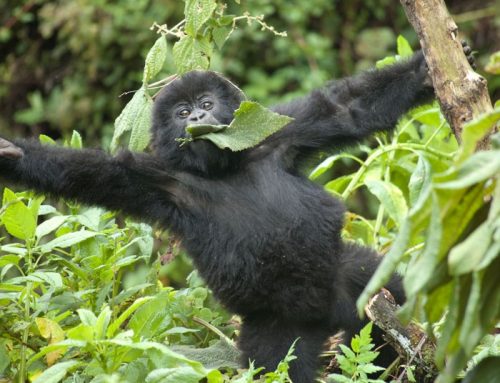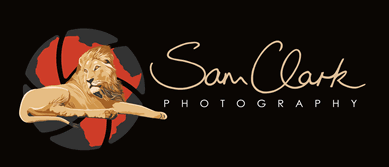Mountain gorillas are shy endangered ground dwelling apes, tailless, black in color and herbivorous in that I mean that they feed on grass, tree leaves, stem, foliage and some fruits. These apes are big in size weighing up to about 210 kilograms and reach up to 1.5 meter height when standing. These apes live in a group named “troop” led by the dominant Silver back, they usually small huts for shelter constructed out of tree leaves and grassroots. Africa is a great destination mostly known for Mountain Gorillas by travelers which are located in the Eastern part of it in countries named Uganda and Rwanda.
Uganda is one of the mostly known gorilla hosting countries in the World and it’s found in the Eastern part of the African continent bordering South Sudan in the North, Kenya in the East, Democratic Republic of Congo and Rwanda in the West and Tanzania in the South. It is known to be hosting the most part of the World’s gorilla Population, it has a wide range of wildlife primates to visit in its top ten national Parks plus wide scope of different bird species to sight without ignoring tremendous physical features including Mountain Rwenzori and Elgon, falls with River Nile sourcing from here and that’s why Uganda is called “The Pearl of Africa” really you will witness it on your gorilla photo safari in Uganda.
While in Uganda the Shy endangered mountain gorillas are only found in two major National Parks named Bwindi Impenetrable Forest National Park and Mgahinga Gorilla National Park. Therefore, if you are looking forward to doing a gorilla safari in Uganda Bwindi Impenetrable Forest National Park and Mgahinga Gorilla National Park will be your turning point.
Bwindi impenetrable Forest National Park:
It is a protected area located in the western part of Uganda home to the part of the World’s shy endangered Mountain Gorillas. This park is part of the Bwindi Impenetrable Forest and is situated along the Democratic Republic of the Congo border next to the Virunga National Park and on the edge of the Albertine Rift. Composed of 331km2 of both montane and lowland forest, it is accessible only on foot since its characterized with thick impenetrable forest where the Mountain Gorillas live.
It provides habitat for 120 species of mammals, 348 species of birds, 220 species of butterflies, 27 species of frogs, chameleons, geckos, and many endangered species. Floristically, the park is among the most diverse forests in East Africa, with more than 1,000 flowering plant species, including 163 species of trees and 104 species of ferns.
It is known to be hosting the most part of Uganda’s Gorilla population grouped in four sectors named Buhoma, Nkuringo, Ruhija and Rushaga sector with each having more than two Gorilla families apart from Nkuringo sector which has only one Gorilla family. Rushaga sector located in the South Eastern part of Bwindi is known to be with the most Gorilla families for trekking.
Mgahinga Gorilla National Park:
It is also located in the Western part of Uganda near Bwindi inclusive of the Virunga Massif. It includes three of the eight Virunga Mountains volcanoes: Mount Muhabura, Mount Gahinga, and Mount Sabyinyo. These dormant volcanoes are international mountains, with Muhabura and Gahinga on the Uganda/Rwanda border, and Sabyinyo a tripoint on the Uganda/Rwanda/Democratic Republic of the Congo borders.
It covers 33.7km2 of Area, it is characterized with both tropical moist broad leaf forests and montane forests and its known to be the second Gorilla hosting destination in Uganda with only one Gorilla family for trekking named the Nyakagezi family being led by a dominant silver back named mark. Since Mgahinga is near Rwanda and Democratic Republic of Congo borders these Gorillas usually cross borders and that’s why it was not stable. Apart from Gorillas it’s also known for other wildlife primates like Golden Monkeys which are usually found in the Bamboo forests.
Rwanda is also among the top destinations known for mountain gorillas in Africa and it’s also located in the eastern part of the African Continent near Uganda the Pearl of Africa. It borders Democratic republic of Congo and Uganda in the North, Tanzania in the East, Congo in the South and Burundi in the South. Shy Endangered Mountain gorillas in Rwanda are only found in Volcanoes National Park which is the mostly known destination to visit in Rwanda commonly known for the gorillas plus Golden monkeys among other wildlife primates. Therefore, planning for your gorilla photo safaris in Rwanda Volcanoes National Park should be your turning point.
Volcanoes National Park:
It is located in the north western part of Rwanda created in 1925 to protect the shy endangered Mountain gorillas which were exposed to hunting. It borders Virunga National Park in Democratic Republic of Congo and Mgahinga Gorilla National Park in Uganda. It is home to five of the eight volcanoes of the Virunga Mountains (Karisimbi, Bisoke, Muhabura, Gahinga and Sabyinyo), and spans 160 km2 covered in rain forest and bamboo forest.
It has over twelve Gorilla families for trekking in its jungle and some of the Gorilla families include Susa, Kwitonda, Umubano, Amahoro, Sabyinyo, Agasha, Hirwa, Bwenge and Ugenda Gorilla family. Always a group of eight people is allowed per gorilla family.
What is required for the better excursion of this gorilla photo safari?
To visit these shy endangered Mountain Gorillas in the Jungle you must buy a permit which costs $700 USD per person in Uganda and $1500 USD per person in Rwanda and always this money is paid in advance to book for your permit, if you are to visit both Uganda and Rwanda you have to apply for a multiple Visa which costs $100 USD per person, lastly you must be with a valid yellow fever vaccination Card to be issued entry permission.
What to Bring for your Gorilla photo Safari in Uganda & Rwanda.
Cameras:
Decent quality digital SLR are the best tool for the job in most mountain gorilla photo Safaris. If you are lucky enough to own a full frame SLR then this is best due to the higher performance in low light situations that you are likely to find yourself in. However, that is not to say that a cropped sensor will not do a decent job for you. It is worth noting that on a cropped sensor SLR your zoom lenses will be extended depending on the size of the sensor. A 1.6x sensor for example will multiply the focal length of your lenses by that factor, this can be especially useful for other parts of your safari, and for example, a 200mm lens on a 1.6 x sensor would be equivalent to a 320mm zoom (200 x 1.6 = 320.
Lenses:
When selecting lenses many people elect for long telephoto zooms when traveling on safari. While these are often the best tool for the job when you are in some places like Bwindi Impenetrable National Park, they can be a bit too much when visiting the mountain gorillas. The reason for this is that, ideally, you should be around 7 meters from the gorillas, which is significantly closer than you are likely to be to a leopard in a tree.
If somebody else was paying for it (and carrying it, I would love to go with 2 x Canon 1dx bodies fitted with Canon EOS battery grips, a medium telephoto such as a Canon EF 24-70mm f/2.8L II USM coupled with a Canon EF 70-300mm f/4-5.6L IS USM. It is all well and good saying that this is best or that is the best, but I shot exclusively on a Canon 50D with a Sigma 18-250mm f/3.5-6.3, which is significantly cheaper, and lighter.
Water proof Bags:
You should come with Water proof bags for your photography Cameras as chances are high rain find you in the Jungle while on the photography excursion and this best to protect your camera from Water.
Other Gears:
Strong Hiking Shoes, trousers, long sleeved shirts, Jackets & jumpers and insect repellents should not miss on your parking list as the weather conditions tend to change.



Leave A Comment